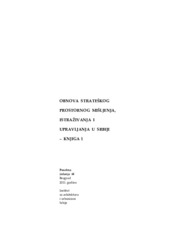Prikaz osnovnih podataka o dokumentu
Teritorijalna/prostorna dimenzija socijalne isključenosti
Territory/Spatial Dimension of Social Exclusion
| dc.creator | Jokić, Vesna | |
| dc.creator | Petovar, Ksenija | |
| dc.date.accessioned | 2023-02-27T14:05:25Z | |
| dc.date.available | 2023-02-27T14:05:25Z | |
| dc.date.issued | 2011 | |
| dc.identifier.isbn | 978‐86‐80329‐70‐3 | |
| dc.identifier.uri | http://raumplan.iaus.ac.rs/handle/123456789/734 | |
| dc.description.abstract | Apstrakt: Tema socijalnog razvoja u poslednjoj deceniji 20. veka postaje sve aktuelnija. Naime, opšteprihvacena formula intenzivnog ekonomskog rasta koji će po automatizmu obezbedivati socijalno blagostanje, prouzrokovala je brojne negativne posledice. Povecanje ekonomskih i socijalnih nejednakosti, redukcija socijalnih prava kao i opadanje kvaliteta socijalnih usluga dovelo je znacajan broj gradana u zamku siromaštva I iskljucenosti iz opštih društvenih tokova. Jaz izmedu bogatih i siromašnih širi se i produbljuje, povecava se razlika izmedu gradskih i seoskih podrucja, izmedu i unutar regija, govori se o društvu s dve brzine (two-speed society). U takvim okolnostima, tema socijalnog razvoja sve više se stavlja na dnevni red. Socijalni razvoj se s razlogom definiše kao integralni faktor održivog ekonomskog razvoja. Bez socijalnog razvoja nije moguce jacati socijalnu koheziju koja je postavljena kao jedan od strateških ciljeva i koa temelj stabilnog razvoja evropskog društva. Jedan od pristupa u unaparedenju socijalnog razvoja je borba protiv siromaštva i socijalne iskljucenosti, odnosno jacanje procesa socijalne ukljucenosti, koji su prihvaceni kao kljucni element daljeg razvoja evropskog socijalnog modela. Prostorna distribucija indikatora socijalne iskljucenosti pokazuje da je dostupnost usluga od javnog interesa jedan od osnovnih činilaca društvene nejednakosti i generiranja obima socijalne iskljucenosti. | sr |
| dc.description.abstract | Abstract: Theme of social development in the last decade of the 20th century is becoming increasingly topical. The generally accepted formula of intensive economic growth that will automatically provide social welfare, has caused many negative consequences. Increasing economic and social inequality, reduction of social rights, as well as the decline in the quality of social services has resulted in a significant number of people in poverty and exclusion from the general social trends. The gap between rich and poor is wider and deeper, increasing the difference between urban and rural areas, between and within regions, discusses a two-speed society. In such circumstances, the theme of social development is increasingly placed on the agenda. Social development is rightly defined as an integral factor in sustainable economic development. Without social development is not possible to strengthen the social cohesion that is set as one of the strategic objectives and the basis of stable development of European society. One approach to its improvement in social development is the struggle against poverty and social exclusion and strengthening social inclusion process, which were accepted as a key element for further development of the European social model. Spatial distribution of indicators of social exclusion shows that the availability of services of public interest is one of the main factors of social inequality and generating volume social exclusion. | sr |
| dc.language.iso | sr | sr |
| dc.publisher | Beograd : Institut za arhitekturu i urbanizam Srbije | sr |
| dc.relation | info:eu-repo/grantAgreement/MESTD/Integrated and Interdisciplinary Research (IIR or III)/47014/RS// | sr |
| dc.rights | openAccess | sr |
| dc.source | Održivi prostorni razvoj Podunavlja u Srbiji - Knjiga 1 | sr |
| dc.subject | socijalni razvoj | sr |
| dc.subject | socijalna isključenost | sr |
| dc.subject | prostorna dostupnost | sr |
| dc.subject | social development | sr |
| dc.subject | social exclusion | sr |
| dc.subject | spatial availability | sr |
| dc.title | Teritorijalna/prostorna dimenzija socijalne isključenosti | sr |
| dc.title | Territory/Spatial Dimension of Social Exclusion | sr |
| dc.type | bookPart | sr |
| dc.rights.license | ARR | sr |
| dc.citation.issue | 68 | |
| dc.citation.spage | 127 | |
| dc.citation.epage | 149 | |
| dc.citation.rank | M45 | |
| dc.identifier.fulltext | http://raumplan.iaus.ac.rs/bitstream/id/3034/Vesna_2011_68_r.pdf | |
| dc.identifier.rcub | https://hdl.handle.net/21.15107/rcub_raumplan_734 | |
| dc.type.version | publishedVersion | sr |

